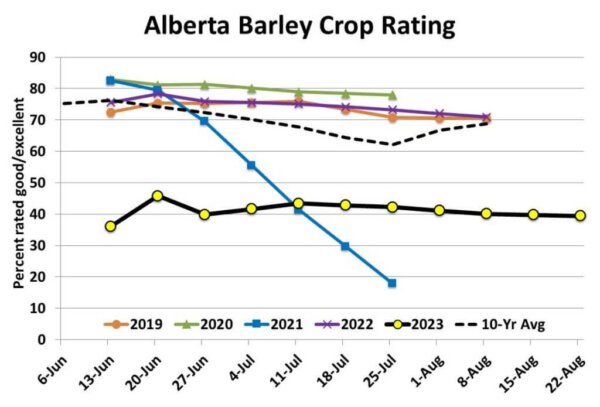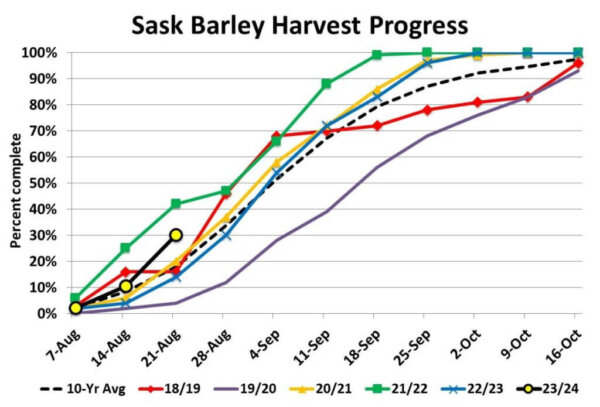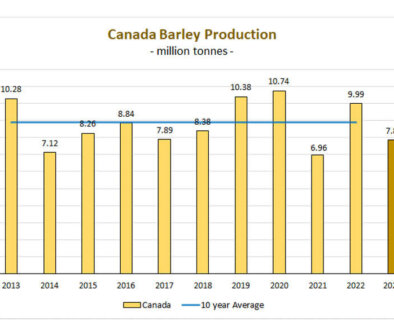CROP PROGRESS REPORT – August 29, 2023
This report may not be reproduced or redistributed in whole or in part without permission of the Canadian Malting Barley Technical Centre.
Harvest is now in full swing in western Canada. Overall crop development has been ahead of normal across a good portion of the Prairies due to the hot and dry conditions through much of the season, allowing for an initial early start to harvest although recent rain events caused some temporary delays. This hasn’t caused a material setback in completing the harvest in a timely fashion, but the rain has caused some quality problems for the barley crop in certain areas with reports of pre-harvest sprouting, though the extent of the damage is still uncertain.
As of the writing of this report, the barley harvest in western Canada is now estimated to be around 50% complete, and with significant progress being made it’s likely most of the crop will be off in the next couple of weeks if weather cooperates. The current forecast isn’t completely free of any showers, but generally is conducive to good harvest advancement.

Statistics Canada’s latest 2023 production estimate, released on August 29th,and based on satellite imagery projects the Canadian barley crop at 7.92 mln tonnes, below the 5-year average of 9.2 mln tonnes and well below the average estimates of analysts of 8.4 mln tonnes. The decline is due to a projected yield of 55.3 bu/acre, compared to a 5-year average of 64.1 bu/acre, while seeded area was essentially in line with the 5-year average at 7.3 mln acres.

The pace of harvest advancement at this time of year is well ahead of what provincial government reports are able to keep up with. The highly variable conditions across western Canada, and within local areas, also make it difficult to have a good assessment of overall crop size and quality. Anecdotal reports are mixed, although it’s not uncommon to hear of yield results on individual farms being somewhat better than anticipated from initial low expectations. Quality concerns relate to very dry conditions in some regions, and late season rain in others. It will require another 2-3 weeks of harvest reports to get a good picture of the quality and size of the 2023 Canadian barley crop.
ALBERTA
The latest Alberta Agriculture crop report as of August 22nd showed significant precipitation fell across a portion of the province in the previous two weeks, in some cases ranging from 40 mm up to as much as 80 mm of rainfall. This has helped late developing crops, although also is causing some delays in advancing harvest.
Alberta’s barley crop was rated 39.4% Good/Excellent as of August 22nd, down 1.7% from two weeks ago, indicating little change overall across the province. The South declined by almost 5%, while the North East improved 3.5%, with most other regions seeing almost no adjustment in their rating. The barley crop was estimated to be 19.8% harvested as of August 22nd.

There has been little change in the yield estimates from Alberta Agriculture compared to two weeks ago, with most crops remaining below their longer-term averages. Barley improved by 1.5 bu/acre, to 55.5 bu/acre, still below the average that is near 60 bu/acre. There is a wide range between regions, reflecting the difference in growing conditions during the season.
Alberta Dryland Yield Estimates as of August 22, 2023

Alberta Agriculture’s 2023 yield forecast is projecting dryland barley at 55.5 bu/acre, up 1.5 bu/acre from their estimate two weeks prior. As reflected in conditions all season, yields vary considerably between regions, with the South being the lowest and the Nort East and North West regions being higher. With the exception of oats, all major crops are looking at below-average yields.
Southern Region (Strathmore, Lethbridge, Medicine Hat, Foremost):
The hot and dry conditions have significantly hurt yields, although they are allowing for rapid harvest progress, with barley estimated to be 47.8% complete as of the provincial report. The region’s barley crop was rated just 18.5% Good/Excellent, with both yield and quality reflecting the impacts of the drought conditions. The Alberta government forecast a yield of 30.6 bu/acre for the region, which fits with individual farmer reports of 20 to 40 bu/acre. There are incidents of yields coming in better than anticipated, although that is based off very low pre-harvest expectations. Anecdotal reports indicate protein ranges from 14% to 16%, with light bushel weight and plumps around 65% to 70%.
Central Region (Rimbey, Airdrie, Coronation, Oyen):
Harvest progress has been delayed by significant rainfall, with 12.9% of the barley in the bin as of August 22dn. Current estimates suggest closer to 25% or more for the crop has been taken off, and advancement should be rapid going forward. Barley was rated 36.5% Good/Excellent, with the southern half of the region generally faring worse than the more northern parts. The yield for the region is estimated at 61.3 bu/acre, after a very hot and dry late May to mid-June period changed into significant rain through the balance of the season. Early protein estimates are thought to be about 0.5% higher than last year, although early harvest samples are from the driest areas, and don’t necessarily fully reflect the region overall.

North East Region (Smoky Lake, Vermillion, Camrose, Provost):
Spring cereals are reported to be at or near full maturity, with some further drying down needed before harvest can progress more rapidly. Barley is estimated to be only 1.4% harvested as of the provincial update, the slowest start in the province, although significant activity will take place very shortly. The secondary growth that was triggered by summer rains is said to be maturing very quickly. The region has the highest rated barley crop in the province, at 62.6 Good/Excellent, with a projected yield of 74.5 bu/acre.

North West Region (Barrhead, Edmonton, Leduc, Drayton Valley, Athabasca):
Recent rain and cool weather is slowing the start of harvest for much of the region, with just 2.5% of the barley crop taken off. Barley is rated at 58.8% Good/Excellent, with an estimated yield of 75.5 bu/acre, the highest in the province. Activity will pick up significantly very shortly.
Peace River Region (Fairview, Falher, Grande Prairie, Valleyview):
Harvest is in the earliest stages as of the provincial report, showing barley at just 1.5% complete on August 22nd, although reports indicate much more has been completed since then. Rain has delayed some of the progress. The barley crop is rated at 52.2% Good/Excellent, with the Alberta government estimating a yield of 53.0 bu/acre. Early reports from some farmers point to yields ranging from 60 – 110 bu/acre, depending on the local area.
SASKATCHEWAN
The Saskatchewan Ministry of Agriculture’s most recent crop report as of August 31st showed that harvest was advancing quickly across the province. The province’s barley harvest is estimated at 42.5% complete, up from 28.5% the previous week, with several areas over half done and a large portion of remaining fields either swathed or ready to straight combine. The harvest is advancing rapidly with the pace ahead of normal.

Rain has caused some delays, and has also negatively impacted quality in certain regions with report of preharvest sprouting. Overnight temperatures dropped quite low across a portion of the northern half of the growing region last week, including a few areas that dipped below freezing, although this is not believed to have caused any widespread damage.

Southeast Region (Moosomin, Weyburn, Moose Jaw, Regina, Qu’Appelle, Minton).
This region was cited as being the furthest along for barley harvest, at 45.9% complete as of the provincial report. Rain has delayed progress, although harvest is ahead of normal.
East central Regions (Melville, Yorkton, Foam Lake, Lumsden, Watrous, Clavet).
The region is reported to have 21.4% of the barley crop harvested, ahead of normal, although rain has caused some delays. There are reports of yields coming in above pre-harvest expectations, ranging from 75 – 90 bu/acre, but also indications of high levels of chitting and sprouting.
Northeast Regions (Tisdale, Melfort, Humboldt, Cudworth, Prince Albert).
The region is further behind than much of the rest of the province for barley harvest, at 20.9% complete as of the provincial update. The slower start is normal, and more progress has been made since then. There are reports of some farms harvesting their barley early on fields where that was possible to avoid the forecast rains and potential negative impact on quality. It’s common to hear of the subsequent rain causing preharvest sprouting. Yields are generally a little better than anticipated prior to harvest.
One farm variety trial indicated yields ranged from 85 bu/acre for Copeland, and to closer to 100 bu/acre for the AAC Prairie and CDC Churchill varieties.
Southwest Regions (Assiniboia, Gravelbourg, Swift Current, Maple Creek, Leader).
The southwest region is amongst the furthest along in the province, with 45.6% of the barley crop harvested as of the Saskatchewan Agriculture update, although most of the area will now be 80 – 100% complete. Parts of the region have received significant moisture, which is hampering harvest, although helping with the extremely short moisture conditions. Yield reports are highly variable, but tend to range from 15-40 bu/acre.
West central Regions (Outlook, Rosetown, Kindersley, Eston, Wilkie, Biggar).
The region is well along in its harvest, with 32.5% of the barley crop taken off at the time of the provincial update. Rain has caused some, but much of the remaining crop should be taken off shortly. Anecdotal reports suggest yields are a little better than expected prior to harvest.
Northwest Regions (North Battleford, Meadow Lake, Maidstone, Lloydminster).
The region has made the least amount of harvest progress in the province, with just 6.7% of barley fields taken off, although that is still ahead of normal for this time of year, and over 20% of the crop is either in swath or ready to be straight combined. Rain has caused some delays.
MANITOBA
The latest Manitoba Agriculture crop report as of August 22th showed the province’s barley harvest was well under way at 26% complete. Progress ranged from being over 50% done in the Interlake and Central regions, to having just started in the Southwest and Northwest. More of the crop has been taken off since the update, although advancement was temporarily disrupted in areas that received rain. The harvest pace is roughly in line with the 5-year average.
Cereal crops are described as being in fair to good condition, although also high variable, something that has been the case all season due to the differing amounts of rainfall.
Manitoba Spring Wheat Conditions by Region as of August 22, 2023

Manitoba doesn’t put out a crop rating for barley, specifically, although spring wheat ratings are a reasonable proxy for cereal crops in general. Over the past month there has been very little change in aggregate, as well as within individual regions.
Northwest region (Russell, Dauphin, Swan River).
Weather conditions have been mixed across the region between periods of hot and dry days mixed with cool and rainy periods. While barley harvest was reported at just 1% complete as of the provincial update, more has come off since then, with most fields close to being ready.
Southwest region (Brandon, Wawanesa, Birtle).
Harvest has been disrupted by rain, although progress has resumed fairly quickly when conditions allowed for it. Strong winds also created some challenges. Crops are drying down quickly, which is facilitating a brisk pace of harvest overall. Barley is reported at 5% complete as of the provincial update, although will be further along by now. The crop is described as having average yields and quality. One farm reported their barley made malting grade, with low to moderate chitting, and yields performing very well given the limited moisture during the season.
Central region (Portage la Prairie, Altona, Carman, Treherne).
The region is furthest along for barley harvest at 60% complete as of the provincial update, with many of the remaining fields having been taken off since then. Mostly dry conditions helped progress, although thunderstorms did cause significant precipitation in some locations. Spring cereal yields are described as being highly variable, depending on rainfall amounts received during the season, with barley general estimated between 70 to 100 bu/acre.
Eastern and Interlake region (Selkirk, Beausejour, St. Pierre).
Harvest progress is mixed across the region, with the Interlake 50% complete as of the provincial update, while the Eastern region was only 10% finished. Both areas will have seen meaningful progress since then, although there are localized storms that resulted in significant amounts of precipitation as well. Spring cereal yields are described as being variable, although in some cases holding up better than expected, with barley average around 80 bu/acre.
The CMBTC does not offer advice or recommendations with respect to production or marketing decisions to the barley industry, and this information should not be construed as such. The information contained in this report is in part contributed by a third-party provider.



